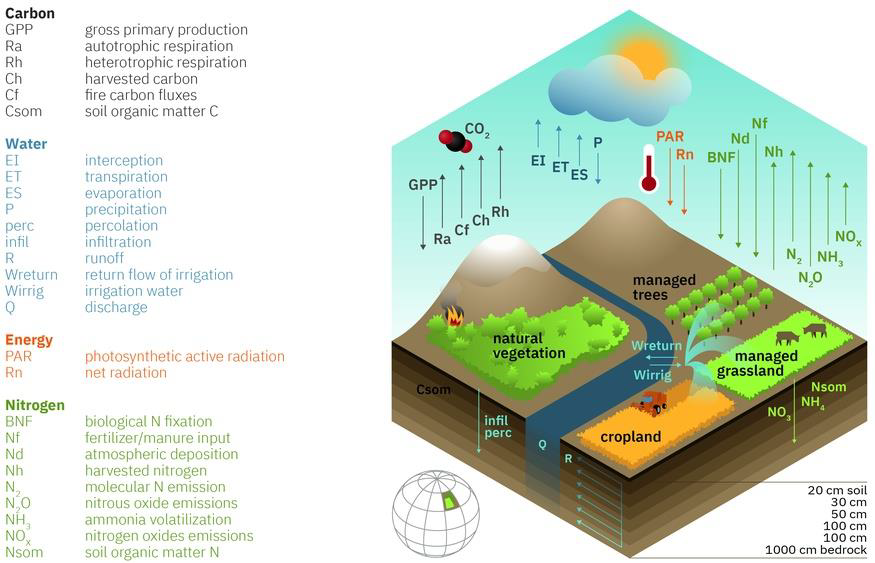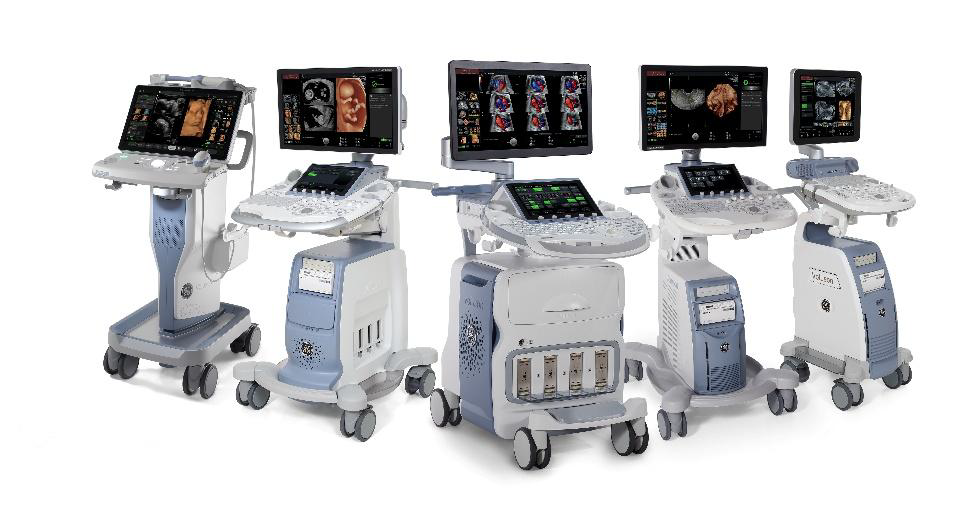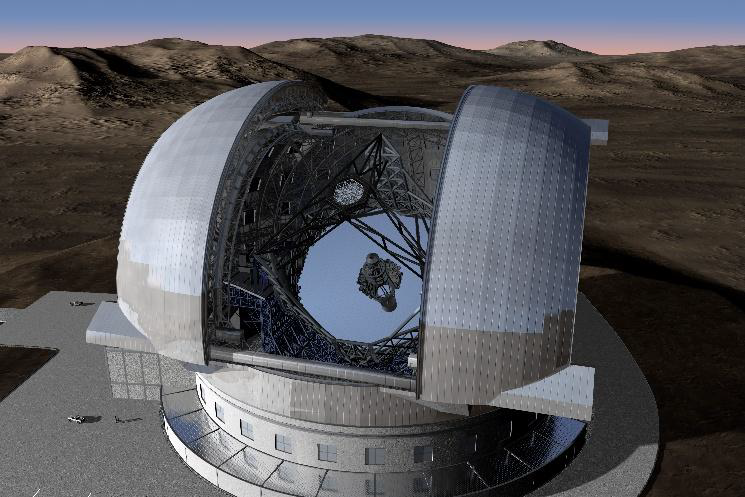Univ.-Prof. Dr. Ronny Ramlau (JKU Linz)
Prof. Dr. Kevin Sturm (TU Wien)
Project description
Climate change alters vegetation dynamics, biodiversity, and biogeochemical cycles which could increasingly reduce the biosphere’s capacity to continue absorbing carbon from the atmosphere. Climate and Earth System models have been developed to predict effects of different global warming trajectories which are then used to assess climate change impacts on multiple sectors. It includes Dynamic Global Vegetation Models (DGVMs) to study the net effects of vegetation dynamics and biodiversity in nature and its energy, water and nutrients cycles interacting with crops and pastures on managed land under climate change.
DGVMs are applied to study the impact of climate and land-use change on the composition and dynamics of natural vegetation as well as growth and harvest of crops and pastures. Over the past decades, new process knowledge and fast-growing observational data sets have allowed to add more processes of vegetation dynamics, such as process-based fire models, detailed hydrological schemes, crop growth and harvest as well as nutrient limitation. One prominent example is the Lund-Potsdam-Jena for managed Land (LPJmL) DGVM with its recently included developments. One of the latest developments (LPJmL-FIT) includes the incorporation of plant trait ecology to improve simulation of biodiversity effects in vegetation dynamics towards greater model realism to simulate actual processes and pattern changes on land.

The LPJmL-FIT model was originally developed for tropical forests and recently applied to European natural forests. Therefore, LPJmL-FIT can be applied now to 4 out of 7 global biomes. However, its computational costs of simulating gap dynamics for about 2000 forest patches per 0.5 x 0.5 longitude-latitude grid cells currently prevent it from applying the model to the global scale which is done at a spatial grid of about 64.000 grid cells. So far, the increasing complexity of the models and the related codes has been tried to match by extended high-performance hardware in combination with parallelization, using, e.g., OpenMP, leading nevertheless to significantly increased computing times. GPU computation, on the other hand, seems currently not to be an option to the code developers, mainly due to the structure of the used algorithms.
In contrast, little has been invested in identifying and optimizing of computationally intensive routines which often have a long model history because they were the core routine from the very first model version. This includes the physiological modeling core of simulating photosynthesis in connection with atmospheric water demand or plant-water stress, allocation of new assimilated carbon to new plant compartments.
Specifically, the growth and competition of individual trees within a forest patch photosynthesis and coupled water stress routines have to be computed for each leaf layer to account for light reduction from the canopy to the forest floor. Finding the optimum between photosynthesis and potential evapotranspiration for a given stomatal conductance at the leaf level, is getting even more complex when nutrient uptake, causing additional costs for the plant, is added in the optimization of three co-limiting factors.
We will in particular focus on the reduction of the computational cost required to bring carbon pools and vegetation composition into equilibrium (model spin-up) with the baseline climate conditions. Moreover, increasing the modeling depth by quantifying physiological processes for several trees having different trait combinations and competing for light and water in a forest patch, further increases computational complexity, which currently cannot be matched, preventing DGVMs from evolving into next-generation global biodiversity-ecosystem models. We believe that by optimizing the used algorithms for the computation of the equilibria will allow to overcome those problems.

About the Hosting Institute
The Institute of Industrial Mathematics was established at JKU Linz in 1988 under the leadership of Univ. Prof. Dr. Heinz Engl. In 2008, Univ. Prof. Dr. Ronny Ramlau succeeded him as head of the institute. The theoretical focus of research lies in the development of solution methods for inverse and ill-posed problems, that is, the stable calculation of information from measured data. The theoretical results obtained by the members of the institute are used in a variety of applications, such as medical image processing – for example, in computed tomography or in the determination of the pulse wave velocity in the brain. The latter can be used as e.g. an indicator for the detection of Alzheimer’s disease. In Cooperation with GE Healthcare, the institute is also involved in the development of modern methods for ultrasound imaging.

Another main area of work is the development of algorithms and software for Adaptive Optics systems of telescopes, e.g. for the ELT (Extremely Large Telescope), which is currently under construction in Chile. It will be the largest “eye” ever directed towards the universe. The first astronomical observation (“First Light”) with the ELT is currently planned for the year 2028.

For the ELT, the institute is particularly involved in the development of reconstruction methods for various types of adaptive optics systems. Especially noteworthy is the development of new algorithms for wavefront reconstruction and atmospheric tomography.
In a more recent cooperation with the Potsdamer Institute for Climate Research (PIK), the institute develops fast algorithms for vegetation modelling.
The Institute for Industrial Mathematics is closely intertwined in its research with the Johann Radon Institute for Computational and Applied Mathematics (RICAM), an institute of the Austrian Academy of Sciences (ÖAW). This institute is composed of various research groups. Prof. Ramlau is head of the so-called “Transfer Group” and also Managing Scientific Director at RICAM.
In cooperation with RICAM, the institute collaborates with various industrial companies in developing mathematical methods, for example, in the automotive, steel, or finance industries.
About the Principal Investigator / PhD Supervisor
Univ. Prof. Dr. Ronny Ramlau
Head of the Industrial Mathematics Institute, Johannes Kepler University, and Managing Scientific Director of the Johann Radon Institute for Computational and Applied Mathematics (RICAM)
Education
- 1988 – 1994 Diploma in Mathematics, University of Potsdam, Germany
- 1994 – 1997 PhD in Mathematics, University of Potsdam, Germany
- 2003 Habilitation, University of Bremen, Germany
Academic Career
- Feb. 1998 – Jan. 1999 Visiting Scholar at the University of Utah, Salt Lake City, Utah
- April 1999 – June 2005 Assistant Professor at the Center for Industrial Mathematics, University of Bremen, Germany
- Sept. 2003 – Dec. 2003 Senior Fellow at the Institute for Pure and Applied Mathematics (IPAM) at the University of California, Los Angeles (UCLA)
- Sept. 2005 – Aug. 2008 Senior Scientist at the Johann Radon Institute for Computational and Applied Mathematics (RICAM), Austrian Academy of Sciences, Linz
- Sept. 2008 – pres. Professor for Industrial Mathematics, Kepler University, Linz, Austria
- Oct. 2010 Call for a Professorship for Inverse Problems, University of Würzburg (rejected Jan. 2011)
- April 2011 – pres. Group Leader Transfer Group at RICAM, Austrian Academy of Sciences, Linz, Austria
- April 2013 – pres. Managing / Scientific Director of the Johann Radon Institute for Computational and Applied Mathematics (RICAM), Austrian Academy of Sciences, Linz, Austria
- April 2013 Call for a Professorship of Numerical Mathematics (W3), University of Siegen (rejected)
- Since Oct. 2013 Head of Industrial Mathematics Institute, Johannes Kepler University Linz
- Aug. 2016 – Feb. 2017 Visiting Scientist, Kent State University, Kent, Ohio, USA
Main Areas of Research
Nonlinear Inverse Problems, Inverse Problems in Astronomy, Regularization Methods, Iterative Methods, Medical Imaging, Tomography, Mathematical Methods in Industry, Sparse Reconstructions, Signal- and Image processing
Editorships
Editor-in-Chief of Electronic Transactions on Numerical Analysis (ETNA) Editor of Inverse Problems
Other Positions
- Head of the Industrial Mathematics Network for Austria and Austrian representative for the European Service
- Network of Mathematics for Industry and Innovation
- Member of the Applied Mathematics Committee of the European Mathematical Society (EMS)
Most Important Publications
1. V. Hutterer, Iu. Shatokhina, A. Obereder, R. Ramlau: Advanced wavefront reconstruction methods for segmented Extremely Large Telescope pupils using pyramid sensors Journal of Astronomical Telescopes, Instruments, and Systems 4 (4), 049005 (2018) DOI http://dx.doi.org/10.1117/1.JATIS.4.4.049005
2. S. Hubmer and R. Ramlau: Convergence Analysis of a Two-Point Gradient Method for Nonlinear Ill-Posed Problems Inverse Problems 33 (2017), doi.org/10.1088/1361-6420/aa7ac7,
3. H. W. Engl and R. Ramlau: Regularization of Inverse Problems, in: B. Engquist (Editor), Encyclopedia of Applied and Computational Mathematics, Springer, 2015
4. R. Ramlau and M. Rosensteiner: An efficient solution to the atmospheric turbulence tomography problem using Kaczmarz iteration. Inverse Problems 28(9), 095004 (2012), http://dx.doi.org/doi:10.1088/0266-5611/28/9/095004
5. M. Zhariy, A. Neubauer, M. Rosensteiner, and R. Ramlau: Cumulative Wavefront Reconstructor for the Shack-Hartmann Sensor. Inverse Problems and Imaging 5(4): 893–913 (2011). http://dx.doi.org/10.3934/ipi.2011.5.893
List of grants within the last 5 years:
1. Doctoral Program Computational Mathematics (FWF-W1214), Project DK8, 2008 – 2020 (1 PhD)
2. Astrophysics in the ELT Era I+II, funded by Hochschulraumstrukturfonds (HRSM), 2015 – 2020 (2 Post- Docs)
3. Reduced Order Modeling, Simulation and Optimization of Coupled Systems (ROMSOC), Project 1, European Industrial Doctorate (EID), founded in the framework of the Horizon 2020 program, 2017 – 2021 (1 PhD)
4. SFB F6805-N36 Tomography across the Scales, Project 5, 2018 – 2026 (1 PhD + 1 PostDoc)
5. Terahertz computer tomography for plastics extrusion (TACTICS), ATTRACT program funded by Horizon 2020, 2019 – 2020 (1PhD)